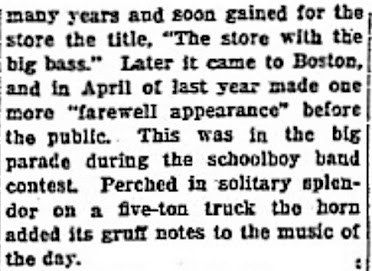Based on earlier images of the band, Conrad is most likely holding one of those large-belled helicon basses, either five guys in from the right in the back row, or six guys in from the right two rows below that.
But what are we to make of that huge tuba toward the middle of the back row? Here's a close-up look at it:
Apart from the engraving on the bell, it is a dead-ringer for the giant tuba that is kept in the band room at Harvard University (being held here by my friends Matt Walters and Steve Dillon):
Here's a closer look at the bell engravings that can be seen today:
It says, "Besson & Co. London England Carl Fischer U. S. Agent. New York." The artist's rendering in the poster shows a giant "BESSON" (or rather "?SSON"), which perhaps was, or maybe even still faintly is, there on the upper part of the bell (I haven't seen the horn myself - yet!).
But, again, everything else matches perfectly, so it seems likely that it is the very same horn - and that's what my research has affirmed. In the March 24, 1929 edition of The Boston Globe, there is the following headline and photo:
The article that follows provides us with the earliest known account of the story behind this giant tuba:
Just how much of this story is true? It's hard to say. But the connection with Gilmore checks out. And the timing is right, as Gilmore had plans to take his band of one hundred to the World's Columbian Exposition in Chicago in 1893 (although his death on Sept. 24, 1892, obviously changed those plans, and I have found no record of that giant tuba appearing at the World's Fair the following year; it may very well have found its way back to that "store window in New York" following the great bandmaster's death).
Further, the folks at Carl Fischer Music recently posted an old photo, said to be from around 1920, showing that horn in front of their main Boston store. It had apparently made the trip from New York by that time:
Finally, I found a photo published in various newspapers in late Spring, 1928, which appears to be showing us that "farewell appearance" in Boston a month or so earlier, where the horn was "Perched in solitary splendor on a five-ton truck":
But how did this giant tuba end up at Harvard? The earliest reference that I could find that connects it to the university is from late December, 1948, and that appears to be the very year that it fell into the Band's hands.
In the 1972 Harvard Bulletin, Christopher Johnson wrote that "It is a documented fact that the Band acquired the instrument from Carl Fischer, Boston, on August 24, 1948, for the sum of $100. Fischer's, it appears, was under the impression that the Band was merely renting; but the clerk had scrawled 'sale' on the slip, and the horn was Harvard's."
That report also mentions the legend that the horn was initially connected with Sousa's Band, which is repeated elsewhere, such as the wikipedia page for "Subcontrabass tuba," which states that it was "built by Besson on the suggestion of American Bandmaster John Philip Sousa, who toured using [it] in his band from 1896-1898." But there is simply no documentation for this claim, and it is almost certainly false.
In 1973, a humorous photo of the giant Harvard tuba, which is very similar to the photo above, featuring the three ladies in 1929, was sent out via UPI to newspapers around the country. Here it is:
This photo also showed up in the Fall 1988 edition of the T.U.B.A. Journal, with the following caption that tells a bit more than the newspapers did:
A dramatization of The Tuba's relative size - oboist Laura Carr became the first human straight mute in 1979 [actually 1973]. Band equipment handler Samuel Shaw (left) and Band Director Tom Everett are holding The Tuba. The drama became real just after this photograph was taken. Ms. Carr, hysterical with laughter, became stuck and had to be extacted [sic] with the assistance of two security guards.
That journal article also shows Sam Pilafian playing the giant horn in 1979 - something that he did numerous times, I'm told.
I hope to be speaking with Sam soon to hear more about this beast of a tuba that goes all the way back to Gilmore's Band in 1892. Stay tuned!
For more on this giant tuba, click here.
For more on this giant tuba, click here.


















































